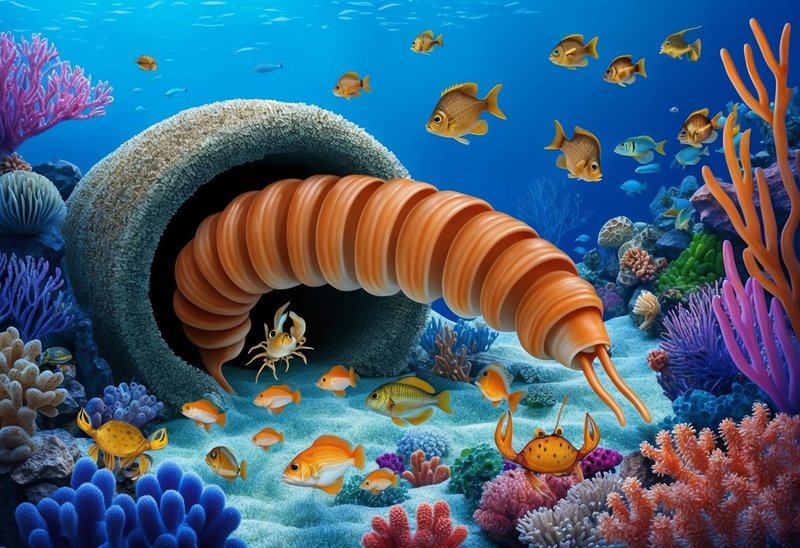
Imagine a hidden predator that lurks beneath the sand, waiting to ambush unsuspecting prey. This is how Bobbit worms operate. Not only are they unique in appearance, with their long, segmented bodies and fierce jaws, but they also play a significant role in their habitat. Let’s dive into the depths of this topic and uncover the truth about Bobbit worms and their impact on coral reefs.
What Are Bobbit Worms?
Bobbit worms, scientifically known as *Eunice aphroditois*, are marine annelids that can grow up to ten feet long. They’re often found buried in the sandy or muddy bottoms of tropical and subtropical oceans. Picture a vibrant coral reef—surrounding it is this creature that resembles a giant piece of spaghetti, with a head that boasts a crown of feathery appendages.
These worms are known for their impressive hunting technique. When prey, like small fish or crustaceans, swims too close, the Bobbit worm bursts from its hiding spot, snapping up its meal with sharp jaws. This predatory behavior can be a little unsettling, but it’s essential to understand that Bobbit worms are a natural part of the reef ecosystem.
How Do Bobbit Worms Interact with Coral Reefs?
You might be wondering how Bobbit worms fit into the bigger picture of coral reefs. Essentially, they play a dual role: they can be both beneficial and harmful. On the one hand, they help maintain balance in the reef ecosystem. By preying on herbivorous fish, they prevent overgrazing of algae, which can otherwise smother coral.
On the other hand, their predatory nature can have negative effects in certain situations. If a Bobbit worm population grows too large, it can lead to a decline in fish species that help keep the coral healthy. This imbalance can create a ripple effect, which ultimately affects the entire reef. Understanding this relationship is key to appreciating the delicate balance of marine life.
Are Bobbit Worms Harmful to Coral Health?
The short answer is: it depends. While Bobbit worms can contribute to the health of coral reefs by regulating fish populations, they can also pose threats in specific circumstances. For instance, if coral reefs are under stress from pollution, climate change, or other factors, the presence of many Bobbit worms might exacerbate the situation.
In healthy environments, these worms can act like any other predator, keeping populations in check. However, if the ecosystem is already weakened, the aggressive feeding habits of Bobbit worms might lead to increased stress on the coral, hindering its recovery. It’s a delicate dance that emphasizes the importance of robust, diverse habitats.
Mitigating the Impact of Bobbit Worms
So, what can be done to manage the impact of Bobbit worms on coral reefs? Here are a few strategies that researchers and conservationists are exploring:
- Monitoring Populations: Keeping track of Bobbit worm populations can help ensure their numbers remain in balance with other species.
- Restoring Coral Reefs: Efforts to restore damaged coral can create a more resilient ecosystem, enabling it to better withstand the pressures from various predators, including Bobbit worms.
- Reducing Pollution: Since pollution affects reef health, reducing it helps all species in the ecosystem thrive, including the Bobbit worm.
Taking these steps can help ensure that Bobbit worms coexist with coral reefs in a way that supports the overall health of the marine environment.
The Role of Bobbit Worms in Marine Biodiversity
Every creature in the ocean has a role, and Bobbit worms are no exception. Despite their predatory nature, they contribute to marine biodiversity. They provide food for larger predators, such as fish and sea turtles. When you think about it, even the Bobbit worm plays a part in sustaining the circle of life in the ocean.
Let’s not forget that biodiversity is crucial for the resilience of coral reefs. A diverse array of species helps maintain balance, ensuring the ecosystem can withstand stresses like climate change or disease outbreaks. Bobbit worms, in their unique way, contribute to this diversity, reminding us that every creature—predator or prey—has a part to play.
Bobbit worms are intriguing creatures that have sparked both awe and concern within marine ecosystems. While they can pose challenges to coral reefs, they are also essential players in maintaining ecological balance. The key lies in understanding their impact and managing their populations responsibly.
As we continue to explore and protect our ocean environments, let’s remember that every species, including the often-misunderstood Bobbit worm, serves a purpose. Ultimately, fostering a healthy, diverse reef ecosystem is the best way to maintain the balance that allows all marine life to thrive together.

